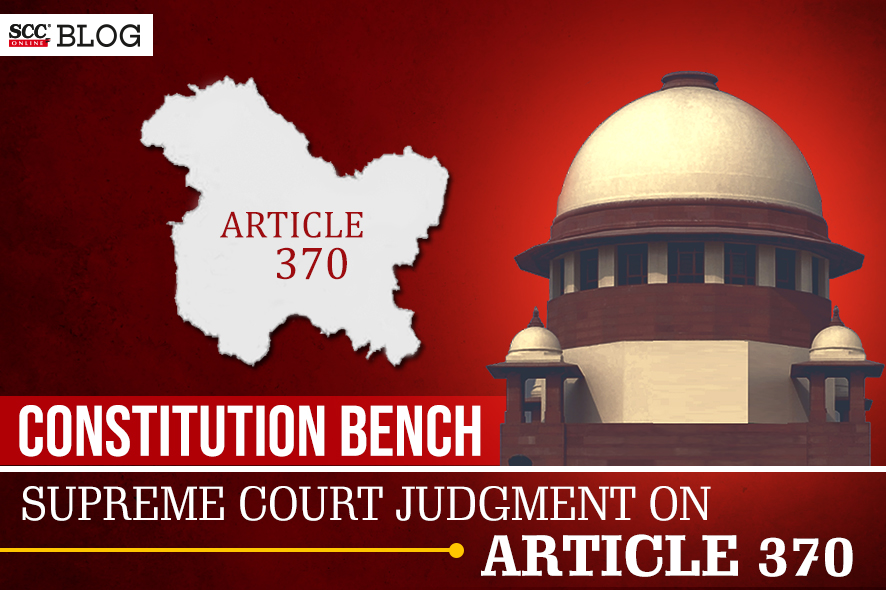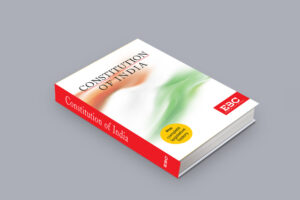Supreme Court: The five-Judge Constitution Bench comprising of Chief Justice of India Dr. DY Chandrachud, Sanjay Kishan Kaul, Sanjiv Khanna, B.R. Gavai, and Surya Kant, JJ., delivered its verdict pertaining to the petitions filed against abrogation of Article 370 by the Central Government. The Bench unanimously upheld the Union’s action of abrogating Article 370. It further directed the restoration of statehood. Dr. DY Chandrachud, CJI particularly directed the Election Commission of India to conduct elections to the J&K assembly by September 30, 2024.
Dr. DY Chandrachud, CJI on Article 370 Abrogation
“Para 2 of CO 272 amending Article 367 is ultra vires because it modifies Article 370 in effect.
The Exercise of power by the President under 370(1)(d) is not mala fide. President did not have to take concurrence of State and can act on Union’s concurrence. Para 2 to CO 272 applying all provisions of Constitution to J&K is valid. The President had the power to issue notification declaring that Article 370 ceases to operate without a recommendation of the J&K Constituent Assembly. It is a culmination of integration process
The views of the State legislature under Article 3 proviso is recommendatory.
We direct that steps shall be taken by the Election Commission of India to conduct elections to the J&K assembly by September 30. Restoration of statehood shall take place as soon as possible.”
“This is a policy decision which completely falls within the realm of the Executive. The Court cannot sit in appeal over the decision of President of India. However, the decision is not beyond the scope of judicial review and can be taken up on the ground of malafide. We do not find that the President’s exercise of power was malafide.”
For challenge to Constitutional Order 273 – 2 Issues considered
1) Whether Art. 370 is a temporary provision?
2) Effect of dissolution of Constituent Assembly and scope of powers under Article 370(3)
Held – Art. 370 is a temporary provision.
On effect of dissolution of Constituent Assembly – Power of President of India u/A 370(3) to issue a notification declaring that Art 370 ceases to exist, subsists even after dissolution of State legislature.
Issue – Whether J&K retained an element of sovereignty when it joined UoI?
State did not retain an element of sovereignty because:
1) Instrument of Accession – nothing would affect the continuance of sovereignty of Maharaja in and over the State
2) Proclamation by Yuvraj Karan Singh – Const. would not only supersede all Constitutional provisions in State inconsistent but also abrogate them. – Reflects full and final surrendor of sovereignty of J&K to India.
3) Neither Constitutional setup or any other factor indicated J&K’s element of sovereignty. Was only to further define the relationship with India.
4) Constitution of J&K, there is a clear absence of a reference to sovereignty
5) State of J&K became an integral part of UoI as evident from Article 1 and 370 of Constitution of India, reiterated in Section 3 of Constitution of J&K which is unamendable.
6) Preamble of J&K Constitution coupled with Article 1 of Constitution of India – indicates subordinate
7) All states in Country have specific Legislative and Executive powers – This is a feature of asymmetric federalism. State does not have integral sovereignty as against other States.
8) Prem Nath Kaul decision – Art 370 was held temporary provision.
“The exercise of power after a proclamation u/A 356 is subject to judicial review, and immunity from judicial scrutiny does not attach to exercise of constitutional powers by State. The Court while judicially reviewing the exercise of power can determine if exercise by Parliament has a reasonable nexus with object sought to be achieved.”
“Petitioners’ Argument that Parliament can assume State’s law making powers when proclamation u/A 356 is issued is not accepted – The purpose of Art 357 is to ensure that while exercising powers of State Legislature pursuant to declaration u/A 356(1), there is no absence of competence for Parliament/President. Art. 357 does not contain a non-obstante provision.”
“Petitioners’ Argument that Union Govt cannot take actions which have irreversible consequences when proclamation u/A 356 is in force is not accepted. The State Legislature’s power u/A 357 must be read in context of 47th Constitution Amendment Act, 1976. ”
Issue – Whether there are limitations on powers of President or Parliament under Article 356?
Held – There are limitations on the power to be exercised by the Union Govt. in the State. A proclamation u/A 356 is operating, the following is concluded:
a) Bench bound by the 9 Judge Bench decision in S.R Bommai case
b) There are limitations on power exercisable after a proclamation u/A 356 is issued because
1) The thread that runs through Part 18 of Constitution when read as whole – Exercise of power when proclamation u/A 356 is in force.
2) Art 356 – President may assume or declare powers u/A 356 (1) – not automatically invoked when proclamation issued u/A 356
3) Art. 356 (1)(A) does not opt for an all or none formula – does not indicate that Union Govt. can exercise part of State functions. Rather indicates that the scope of Union’s power must indicate the circumstances for issuing the proclamation.
4) President has independent power but has to assume function as per Article 356 Clause A
5) President’s power must be desirable/ necessary – reasonable nexus with the object of proclamation.
6) When proclamation u/A 356 is enforced, there are several decisions of the Court – action of Executive on behalf of the State is not subject to challenge – opening up every challenge would lead to chaos and uncertainty.
Standard laid:
A) The exercise of power by President must have reasonable nexus with the object of proclamation
B) Person challenging must prima facie establish that its a malafide/extraneous exercise of power. After that, Union must justify the exercise having reasonable nexus with the object of proclamation
C) The exercise of power by President for everyday administration of the State is not ordinarily subject to judicial review
Issue – Proclamation issued constitutionally valid?
“We are wary that this Court need not adjudicate on the validity of proclamations because:
1) The petitioners’ pleadings indicate that the principle challenged is the abrogation of Article 370, and whether such an action could have been taken during President’s Rule.
2) Even if this Court holds that the proclamation could not have been issued u/A 356, there would be no material relief which could be given for the fact that President’s Rule was revoked on 31-10-2019.
Petitioners have assailed the specific actions which were taken when the proclamation was in force. Those actions breached the constitutional limitation on exercise of power – is substantive challenge forming the fulcrum of the case has been considered.”
Article 370 Judgment by Justice Sanjay Kishan Kaul
Justice S.K. Kaul started with historical background, and said his conclusions are more or less the same, except in one issue, regarding Prem Nath Kaul case, he took a different route.
He said that the purpose of Article 370 was to slowly bring Jammu and Kashmir on a par with the other States of India. Requirement of recommendation of J&K Constituent Assembly cannot be read in a manner making the larger intention redundant. “When the Constituent Assembly ceased to exist, it meant only the proviso to Article 370(3) was rendered otiose. But the main provision existed.” Regarding the amendment of Article 370 using 367, he said when a procedure is prescribed, it has to be followed. Amendment through the backdoor not permissible.
He recommended the setting up of an impartial Truth and Reconciliation committee to investigate and report on the violations of human rights both by the State and non-state actors at least since 1980s and recommend measures for reconciliation. “The Commission must be set up before memory escapes. The exercise must be time-bound. There is an entire generation of youth that has grown up with a feeling of distrust and it is to them that we owe the greatest day of liberation. It is for the government to decide the manner in which the Truth and Reconciliation Commission must be set up, considering the sensitivities of the issues involved. The Commission must not turn into a criminal court and must be offering a platform for dialogue. He referred to Truth and Reconciliation Commission set up in South Africa.”
Justice Sanjiv Khanna on Article 370
My order is not a judgment. Both judgments uniformly agree that Article 370 of Constitution of India was a mixture of asymmetric federalism and not sovereignty and did not have a permanent character. Abrogation of Article 370 does not negate the federal structure as citizens living in J&K do and will enjoy the same status and rights as given to the citizens residing in other parts of country.
Para 2 of CO 272 by which Article 370 was amended is ultra vires and bad in law, albeit, it can be sustained in view of corresponding power u/A 370(1)(d). CO 373 is valid.
Background – Article 370 Abrogation
On 05-08-2019, the Central Government had abrogated Articles 370 and 35-A of the Constitution of India. Parliament had passed the Jammu and Kashmir (Reorganisation) Act, 2019, which provided for the reogranisation of the State of Jammu and Kashmir and bifurcated the State into two Union Territories — Jammu and Kashmir with a legislature and Ladakh, without one.
After President of India’s declaration, all the provisions of Article 370 ceased to be operate except for the provision that: “All provisions of this Constitution, as amended from time to time, without any modifications or exceptions, shall apply to the State of Jammu and Kashmir notwithstanding anything contrary contained in Article 152 or Article 308 or any other article of this Constitution or any other provision of the Constitution of Jammu and Kashmir or any law, document, judgement, ordinance, order, by-law, rule, regulation, notification, custom or usage having the force of law in the territory of India, or any other instrument, treaty or agreement as envisaged under Article 363 or otherwise.”
Prior to the substitution, Article 370 granted a special status to the State of Jammu and Kashmir and provided for “Temporary provisions with respect to the State of Jammu and Kashmir”, under an Instrument of Accession signed with India, which enabled the State to join India, but only with a grant of special status.
Several writ petitions were filed before the Court against the abrogation of Article 370 and reorganisation of the State of Jammu and Kashmir. While hearing a batch of these petitions, the Court had previously refused to refer the petitions challenging the constitutional validity of the Centre’s move to abrogate Article 370 to a larger bench. The Court heard the matter after a period of more than 2 years.
Soon after the matter was back on track, the Constitution Bench allowed applications of the two main petitioners- Dr. Shah Faesal and Shehla Rashid, who sought deletion of their names from the array of the parties and with the consent of all the counsels the cause title of the petitions was amended to ‘In Re: Article 370 of the Constitution’ for the convenience of reference.
The Bench reserved its verdict on 05-09-2023, after conclusion of the sixteen- days long hearing.








